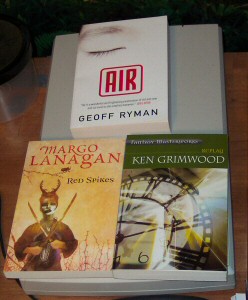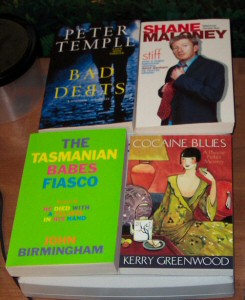I have been meaning for a while to write about the fruits of my book-buying excursion while in Melbourne.
In some ways it was a much less fruitful day than I had been hoping, partly because I was feeling a bit delicate on the day I did the rounds of the bookstores–it was my birthday, and I was feeling delicate because of the night before–and partly because the stores didn’t have what I had hoped. Oh, and partly because books appear to be relatively expensive in Australia, even for locally produced works.
In other unexpected ways it was very successful, on which subject more later…
I’m not sure what I was hoping for: a ton of Australian authors I had never heard of? A lavish spread of Margo Lanagan (or Elizabeth Knox, or Damien Broderick, or Stephen Dedman, or Sean McMullen, or …) books that I hadn’t already read? Just something exotic or uniquely Australian?
Well, I didn’t find those things–even when I went into SF specialty bookstores like Minotaur. What I did find was mostly the same selection of books that I have at home (even the same split between US and UK editions for many books), but for more money. I did manage to find a few other things, though.
For instance, I did find these things:
Now, I intend to get the Knopf hardcover of Red Spikes, because I want to have it in the more durable form, because I want it to match the hardcovers of White Time and Black Juice already on my shelves, and most of all because the cover is much prettier. Still, given the chance to grab a copy to read on the plane home, rather than waiting until October, I went for it–and really, I wanted to be able to say I had bought a Margo Lanagan book in Australia.
(On the off chance that you haven’t heard about Lanagan, you could start with this review of Red Spikes.)
The other two are UK editions, and have no special Australianess, that I grabbed for reading at the hotel. I’ve been meaning to get Air since Gwenda enthused so passionately about it quite some time ago.
Replay, on the other hand, I used to have a ratty used-bookstore copy of, but I seem to have lost it sometime the last couple of decades. So I thought one of the Fantasy Masterworks copy would be welcome on the shelves here.
Where I did have significant success, though, was in the mystery genre. My guide to Melbourne book stores was very knowledgeable and gave me some excellent recommendations.
For instance:
Now, let me start by saying that the Tasmanian Babes Fiasco is hardly a mystery, but it is very much distinctly Australian. I had previously read He Died With A Felafel In His Hand, but had never heard there was a follow-up–so grabbing this was a “no brainer” for me, especially when my guide added his recommendation.
I really quite enjoyed reading it–significantly more than Felafel–and while I’ve never lived the life that’s shown in the books, I know lots of people who have (at least the North American version), and I’ve certainly visited the house.
The Kerry Greenwood book, Cocaine Blues, is the first of her series of Phryne Fisher books. These are light historical mysteries, set in the Melbourne of the Roaring Twenties, with a super-competent flapper-style libertine as the heroine. While I had actually listened to about twelve of these books in the car
The big wins, though, were the other two books.
While discussing distinctly Australian mysteries with my native guide, he came out strongly in favour of Peter Temple and Shane Maloney. In particular Temple’s Jack Irish series, and Maloney’s Murray Whelan series, as both excellent mysteries and uniquely Melbournian books.
Well, I guess my tastes line up pretty well with his in some ways, since I devoured both the first two Jack Irish books, and the first Whelan, on the plane home. And I definitely wanted more, resulting in my ordering a big stack of Aussie mysteries. (Why isn’t there Amazon.co.au or something? I had to order these direct from the publisher, which worked since both series are from the same publisher. It turns out some of Temples books are in print from Random House Canada, but even if I wanted to wait for them to get all in print here, I’d be worried about artificial translations. See below.)
Temple’s series is Melbourne noir. I don’t know what else to call it–it’s shady lawyers, crusty old artisans, crooked horse racing, sporting clubs full of old men, and as of the second book it’s also international intrigue, spooks, and corporations that seem to be invisible to law enforcement. Even when the plotline gets global, the story and the lead character, and inextricably linked to Melbourne. Jack Irish out of Melbourne is like Marlowe out of L.A., or McGee away from the water–you can imagine it, but it’s wrong. It’s also compulsively readable.
I had heard of Temple previously–his Identity Theory has been on my “reliably recommended” list for a while, but this is the first reading I’ve done in his oeuvre. While I’m through all the Jack Irish books now, I’ve got a lot more Temple to look forward to, and most of it is easily available here in North America.
Maloney’s series is more political thriller and less mystery. It reminds me of an Australian version of Michael Dobbs‘ Goodfellowe, MP books, but darker, more local, and with a meaner sense of humour. Again, the stories and characters are completely bound to Melbourne, and are compulsively readable.
Since there were some Australian TV movies made of the Whelan books, the easily available copies of the first book had the “movie cover”. Since I was essentially gambling when I picked the book up, I didn’t mind. When I decided that I wanted to read the whole series, I needed to buy another copy of the first book, since I hate movie covers. (Of course, this means I could pass on the movie edition to someone else. Karma.) I would, incidentally, love to get my hands on a copy of those movies–it appears that the P2P world is letting me down for once.
I actually saw an article this week about Article in The Age about Shane Maloney‘s new Murray Whelan book, Sucked In. I’m having a copy sent to me, by the same guy who showed me around Melbourne’s book stores.
As an aside, I was amused when I found Maloney’s article online about enduring translations of one’s works –especially in the case of an author who writes in a local dialect.
In my case, the issue is compounded by the fact that I write (as stated on the title page of my German editions) in Australian English. And our native dialect being a notoriously arcane mode of expression, I can’t help but wonder if an intelligible rendering into another language is even possible.
My initiation into the world of translation began with a stream of recommendations and queries from my American publisher. Initially, these were concerned with minor modifications, a little light tinkering at the margins. Spelling needed to be brought into line with American usage ( -ise endings became -ize, colour became color). False cognates and unfamiliar diction had to be ironed out (“shopping-trolley” v “grocery cart” and “diary” v “calendar”). And certain unfamiliar items of vocabulary required clarification.
Could I please provide meanings and possible replacements for the following terms? Franger. Duco. Shoot through. Op shop. Furphy. Laminex. Ruckman. Fibro. A piece of piss. An unreconstructed Whitlamite.
(Just after that bit, he gets righteous about Americans wanting to change his Australianisms. Go read it.)
For the record I had no problems with anything in Maloney’s books, most of it being obvious by context, or being things I had encountered before. (OK, I had to do a bit of reading online to understand what an ‘unreconstructed Whitlamite’ is, I admit.)
Temple, on the other hand, lead to one of the funniest misunderstandings ever.
At one scene in his book, we have an outdoor meeting between two hard men, and our narrator describes the guy he’s meeting as wearing a jumper and beanie due to the unseasonable weather.
Now, the word “jumper”, in the context of clothing, means “one piece cotton outfit for an infant“. And “beanie” makes me think of propeller beanies. Imagining a grown man wearing an infant’s outfit and a propeller beanie can really shatter any suspense, and certainly removes any sense of “hard man” from the proceedings.
Well, it turns out that what an Australian calls a beanie is what a Canadian would call a toque. (Americans don’t seem to have a distinct name for it). And “jumper” in Australian is apparently just “sweater” in North American.
Anyway, the summary is: pretty much a strike out in uniquely Australian SF (couldn’t even find the early Lanagan books that I know exist), but great success in Melbourne-related mysteries.




2 comments for “Book-hunting in Melbourne”